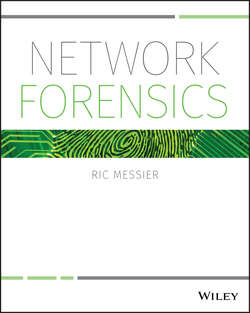Network Forensics

Реклама. ООО «ЛитРес», ИНН: 7719571260.
Оглавление
Messier Ric. Network Forensics
Introduction
What This Book Covers
How This Book Is Organized
1. Introduction to Network Forensics
What Is Forensics?
Incident Response
The Need for Network Forensic Practitioners
Summary
References
2. Networking Basics
Protocols
Request for Comments
Internet Registries
Internet Protocol and Addressing
Transmission Control Protocol (TCP)
User Datagram Protocol (UDP)
Ports
Domain Name System
Support Protocols (DHCP)
Support Protocols (ARP)
Summary
References
3. Host-Side Artifacts
Services
Connections
Tools
Summary
4. Packet Capture and Analysis
Capturing Packets
Packet Analysis with Wireshark
Network Miner
Summary
5. Attack Types
Denial of Service Attacks
Vulnerability Exploits
Insider Threats
Evasion
Application Attacks
Summary
6. Location Awareness
Time Zones
Using whois
Traceroute
Geolocation
Location-Based Services
WiFi Positioning
Summary
7. Preparing for Attacks
NetFlow
Logging
Antivirus
Incident Response Preparation
Security Information and Event Management
Summary
8. Intrusion Detection Systems
Detection Styles
Host-Based versus Network-Based
Architecture
Alerting
Summary
9. Using Firewall and Application Logs
Syslog
Event Viewer
Firewall Logs
Common Log Format
Summary
10. Correlating Attacks
Time Synchronization
Packet Capture Times
Log Aggregation and Management
Timelines
Security Information and Event Management
Summary
11. Network Scanning
Port Scanning
Vulnerability Scanning
Port Knocking
Tunneling
Passive Data Gathering
Summary
12. Final Considerations
Encryption
Cloud Computing
The Onion Router (TOR)
Summary
About the Author
About the Technical Editor
Credits
WILEY END USER LICENSE AGREEMENT
Отрывок из книги
One of the best things about the different technology fields, should you have the stomach for it – and many don't – is the near constant change. Over the decades I have been involved in technology-based work, I've either had to or managed to reinvent myself and my career every handful of years or less. The world keeps changing and in order to maintain pace, we have to change too. In one of my incarnations that ended not many months ago now, I ran graduate and undergraduate programs at Champlain College in its online division. One of my responsibilities within that role was overseeing development of course materials. Essentially, either I or someone I hired developed the course and then I hired people who could teach it, often the people who did the development, though not always.
In the process of developing a course on network forensics, I discovered that there wasn't a lot of material around that covered it. At the time, I was able to find a single book but it wasn't one that we could make use of at the college because of policies focused on limiting costs to students. As a result, when I was asked what my next book would be, a book on network forensics that would explore in more detail the ideas I think are really important to anyone who is doing network investigations made the most sense to me.
.....
The MD5 hash value for that file is 2583a3fab8faaba111a567b1e44c2fa4. No matter how many times I run the MD5 hash utility against that file, I will get the same value back. The MD5 hash algorithm is non-linear, however. This means that a change to the file of a single bit will yield an entirely different result, and not just a result that is one bit different from the original hash. Every bit in the file will make a difference to the calculation. If you have an extra space or an end of line where there wasn't one in the original input, the value will be different. To demonstrate this, changing the first letter of the text file from an H to a G is a single-bit difference in how it is stored on the computer since the value for H is 72 and the value for G is 71 on the ASCII table. The hash value resulting from this altered file is 2a9739d833abe855112dc86f53780908. This is a substantive change, demonstrating the complexity of the hashing function.
One of the problems with the MD5 algorithm, though, is that it is only 128 bits. This isn't an especially large space in which to be generating values, leading it to be vulnerable to collisions. As a result, for many purposes, the MD5 hash has been superseded by the Secure Hash Algorithm 1 (SHA-1) hash. The SHA-1 hash generates a 160-bit value, which can be rendered using 40 hexadecimal digits. Even this isn't always considered large enough. As a result, the SHA-2 standard for cryptographic hashing has several alternatives that generate longer values. One that you may run into, particularly in the encryption space, is SHA-256, which generates a 256-bit value. Where the 128-bit MD5 hash algorithm has the potential to generate roughly 3.4 × 10^38 unique values, the SHA-256 hash algorithm can yield 1.15 × 10^77 unique values. It boggles the mind to think about how large those numbers are, frankly. Generating a SHA-1 hash against our original text file gives us a value of 286f55360324d42bcb1231ef5706a9774ed0969e. The SHA-256 hash value of our original file is 3ebcc1766a03b456517d10e315623b88bf41541595b5e9f60f8bd48e06bcb7ba. These are all different values that were generated against the same input file.
.....